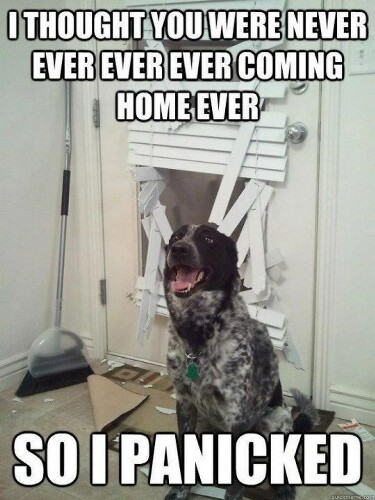Some dogs are prone to anxiety, but it has been my experience that Bull Terriers aren’t one of those breeds. A friend once declared my previous Bully “so laid back he’s horizontal.” Bull Terrier breeders agree that the loveable egg-heads are fun loving and fancy free. Pot Roast, however, my three-year-old Bull Terrier, occasionally breaks the mould, showing signs of separation anxiety over the last year in the form of destructive chewing.
Despite a string of long-term health problems, Pot Roast is a pretty laid back fella. He’s travelled across the country, loves road trips and doesn’t care where he sleeps, as long as it’s relatively cushioned. He’s eaten dinner on the top of mountains before climbing back in the car for eight hours and happily visits any approaching people for love and cuddles. In Pot Roast’s eyes, strangers simply don’t exist.
The largest danger is that as a writer and editor working from home, I am routinely with Roast throughout the day and he’s grown too comfortable with constantly having me around. And while once it was cute that he liked to lay on my lap all day while I typed, this has grown cumbersome considering he’s now a whopping 75 pounds.
Lately, when I leave home for short durations, Pot Roast is showing signs of separation anxiety, which could also be promoted by a cross-country move and my husband away all summer for work. His life has been turned upside down, and as much as I like to think he understands me, the logistical details of change are hard for my canine companion to comprehend. But as I keep returning home after two hours away and finding chewed pillows, blankets and dog beds, I’m running low on patience. I’ve adopted a few new strategies for helping Pot Roast adjust to his new life and the reality that I can’t be his constant sit-upon (at least, not ALL day!
- Treats and toys. If I can stuff it with goodies and create a challenging puzzle for Roast to solve, he’s rewarded with the treats inside. He’s learned that the Kong comes out of the freezer when I leave and peanut butter often follows!
- No big hellos and goodbyes. I used to love coming home to an excited puppy, but have learned it’s best that I just come and go quietly. That way, he learns this is a regular thing, but I always come back.
- Leave a little more. Like the days of toilet training, I’ve been leaving the house for slightly longer increments, depending on the success. If I come home after an hour and he’s hasn’t been destructive, then the next day, I might try 1.5 hours. And so on.
I also have been going to work at the local coffee shop so Pot Roast grows accustomed to me not being around. Hopefully these tips can help you with an anxious dog who wants your 24/7 attention!
By Kelly S. Thompson


